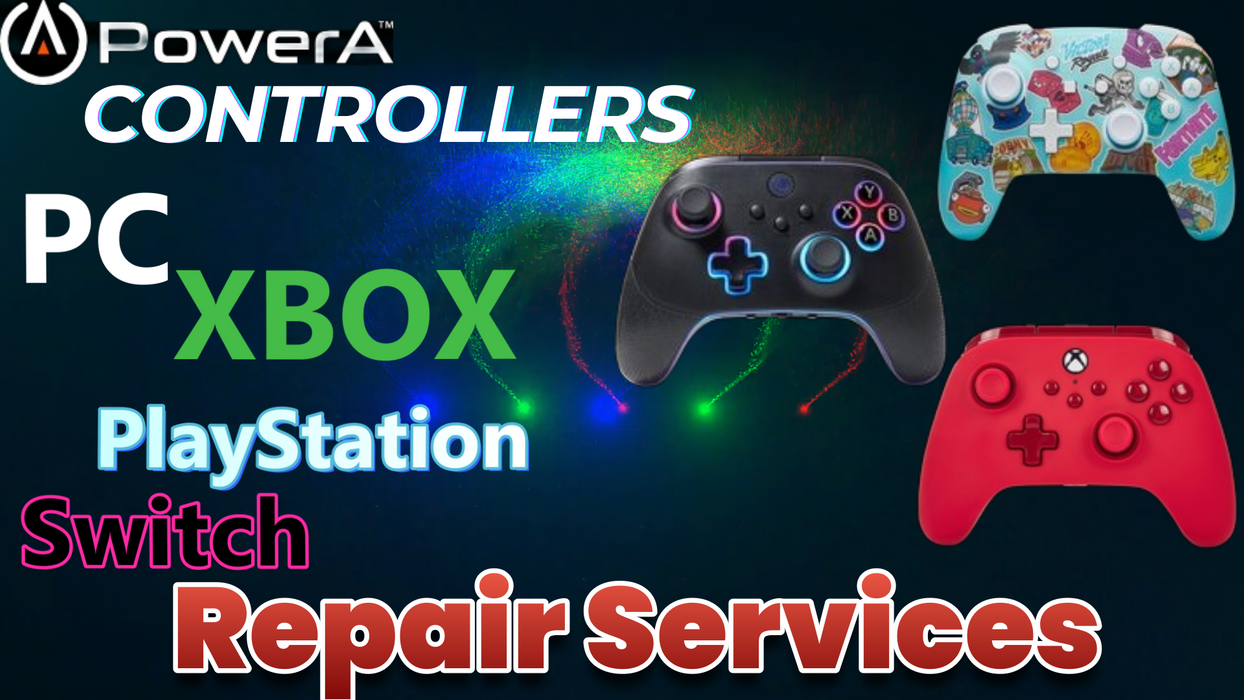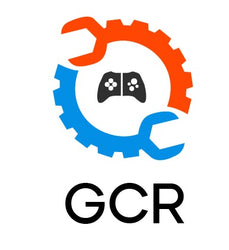

PowerA Gaming Controller Repairs
Get a FREE Quote
PowerA gaming controllers are popular for their affordable price and range of features, but like any gaming hardware, they can experience issues over time. Below are some of the most common problems associated with PowerA gaming controllers and their potential repair solutions:
1. Stick Drift (Analog Stick Drift)
- Problem: The analog stick moves or registers inputs without being touched, causing characters to move on their own in games.
- Cause: Dust or debris inside the analog stick mechanism, or worn-out potentiometers.
- Solution: Clean the analog stick using compressed air or contact cleaner. If the problem persists, the analog stick assembly may need to be replaced.
2. Unresponsive Buttons
- Problem: Buttons on the controller are unresponsive, require excessive force to work, or only register intermittently.
- Cause: Worn-out rubber membranes or dirt under the buttons.
- Solution: Open the controller and clean the button contacts and the rubber membrane. If cleaning doesn’t help, replacing the membrane may be necessary.
3. Broken Trigger Buttons (L2/R2)
- Problem: The L2 or R2 triggers are stuck, unresponsive, or fail to register presses.
- Cause: Broken springs, dirt buildup, or a damaged trigger mechanism.
- Solution: Open the controller and inspect the triggers. If the springs are broken or the mechanism is damaged, replace them.
4. D-Pad Malfunctions
- Problem: The D-pad is either too sensitive or unresponsive, causing inaccurate or unintended inputs.
- Cause: Misalignment of the D-pad contacts, or dirt and grime underneath.
- Solution: Clean the D-pad area and realign it. If the problem persists, replace the D-pad or its contacts.
5. Worn or Loose Thumbsticks
- Problem: The thumbsticks feel loose, wobbly, or have reduced sensitivity during gameplay.
- Cause: Wear and tear over time or a broken internal mechanism.
- Solution: Replace the thumbstick module if it’s too worn out. Tightening any internal screws that hold the thumbstick in place may also resolve the issue.
6. Wireless Connectivity Issues (Wireless Models)
- Problem: The controller frequently disconnects or fails to connect to the console or PC.
- Cause: Low battery, interference from other devices, or outdated firmware.
- Solution: Ensure the controller is fully charged, move it closer to the console, and re-pair it if needed. Firmware updates may also resolve connectivity issues.
7. Charging or Battery Issues (Wireless Models)
- Problem: The controller does not charge, or the battery drains too quickly.
- Cause: Faulty charging port, worn-out battery, or charging cable issues.
- Solution: Try using a different charging cable or inspect the charging port for damage. Replace the internal battery if it's no longer holding a charge.
8. Broken or Faulty Vibration Motors
- Problem: The vibration (rumble) feature doesn’t work, or works inconsistently.
- Cause: Disconnected or broken vibration motors inside the controller.
- Solution: Open the controller to check the connections to the vibration motors. If they are disconnected, reattach them. If the motors are damaged, they may need to be replaced.
9. Headphone Jack Issues
- Problem: The 3.5mm headphone jack doesn’t transmit sound or causes static noise.
- Cause: Dust, debris, or damage to the headphone jack.
- Solution: Clean the headphone jack with compressed air or isopropyl alcohol. If the issue persists, the jack may need replacement.
10. Sticky Buttons
- Problem: Buttons stick in the pressed position or don’t spring back as they should.
- Cause: Dirt, spills, or residue under the buttons.
- Solution: Open the controller and clean the buttons and surrounding area. In some cases, you may need to replace the rubber contact pads.
11. Firmware Issues
- Problem: After a console update, the controller doesn’t work properly or experiences input lag.
- Cause: Compatibility issues between the controller’s firmware and the console or game system.
- Solution: Check for and apply any available firmware updates for the controller. Reinstalling the drivers on PC might also help.
12. USB Cable Connection Issues (Wired Models)
- Problem: The controller disconnects or doesn’t stay connected to the console/PC via the USB cable.
- Cause: A faulty or damaged USB cable or loose USB port on the controller.
- Solution: Test the controller with a different USB cable. If the problem is with the port, you may need to have the USB port repaired or replaced.
13. Calibration Problems
- Problem: The controller is out of alignment, making controls inaccurate.
- Cause: Over time, the controller may become miscalibrated, especially after updates or new game installations.
- Solution: Use the calibration tool on your console or PC to recalibrate the controller. This is often found in the system settings or controller settings menu.
14. Loose or Damaged Internal Wiring
- Problem: The controller randomly disconnects, or certain buttons/inputs fail intermittently.
- Cause: Loose or broken internal wiring due to wear and tear.
- Solution: Open the controller and check for any loose wires. Re-solder or replace the wires if necessary.
15. Non-Functional Shoulder Buttons (L1/R1)
- Problem: The shoulder buttons (L1/R1) stop working or require extra force to respond.
- Cause: Broken internal components or worn-out contacts.
- Solution: Open the controller and inspect the shoulder button mechanisms. Replace any damaged components.
16. Overheating Issues
- Problem: The controller becomes hot during extended use.
- Cause: Prolonged use without breaks or internal short circuits.
- Solution: Allow the controller to cool down periodically. If overheating continues, inspect the internal components for electrical faults.
17. Latency and Input Lag
- Problem: Delays between pressing buttons and in-game actions, leading to unresponsive gameplay.
- Cause: Wireless interference, low battery, or outdated drivers.
- Solution: Use a wired connection or update the controller’s drivers or firmware. Ensure the controller is fully charged if using a wireless model.
18. Loose Housing or Casing
- Problem: The casing of the controller feels loose or wobbles during use.
- Cause: Wear and tear or loose internal screws.
- Solution: Open the controller and check the internal screws holding the casing together. Tighten or replace any loose screws.
19. Cosmetic Wear and Tear
- Problem: The controller’s exterior shows significant wear, such as peeling grips, faded paint, or scratched surfaces.
- Cause: Prolonged use or exposure to rough handling.
- Solution: Replace worn-out grips, or consider using a controller skin or protective cover.
20. Non-Functioning Power Button
- Problem: The controller doesn’t turn on or power up when connected.
- Cause: A faulty power button or battery issue.
- Solution: Check the power button for any damage and replace it if necessary. Ensure the battery is fully charged or replace the battery if it's no longer functioning.
Summary
PowerA gaming controllers can face a range of issues, from analog stick drift and unresponsive buttons to connectivity problems and charging issues. Many of these problems can be resolved with simple cleaning, recalibration, and replacing damaged parts. For more complex issues, such as internal wiring or firmware problems, professional repair services may be required.
If you are unable to resolve the issue with your PowerA Gaming Controller, book now and let us get your controller up and running in no time
Product Reviews
Add customer reviews and testimonials to showcase your store's happy customers.
Author's name
Add customer reviews and testimonials to showcase your store's happy customers.
Author's name
Add customer reviews and testimonials to showcase your store's happy customers.
Author's name
